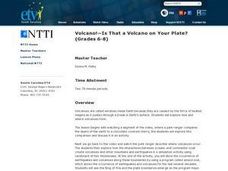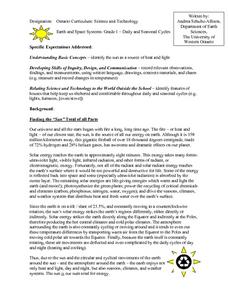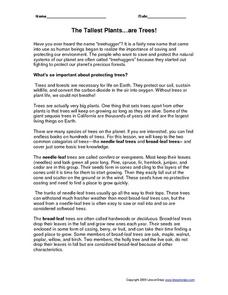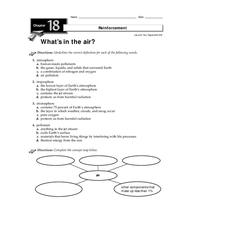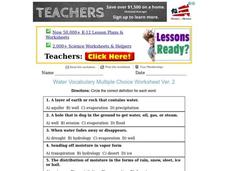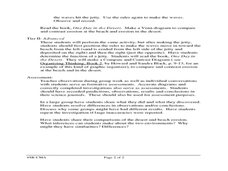Curated OER
Active Faulting in Idaho
Students use CAD maps to explore active faults in Idaho. Through observation of maps, they explore the layers of the Quaternary and Holocene faults. Individually, or in groups, they identify characteristics of faults such as scarps,...
Curated OER
Understanding Salinity
Young scholars discuss why the ocean is salty. They discuss what salinity is. Students are told that is they want to know how much salt is in a body or water, they would use a special scientific tool. They complete an Estuarine Layers...
Curated OER
Volcano! Is That a Volcano on Your Plate?
Students investigate where volcanos come from. In this volcano lesson plan, students watch videos do Internet research and participate in experiments to discover the cause of volcanos.
Curated OER
Air and Water in the Environment
Students demonstrate an awareness of air as a substance that surrounds us and takes up space, and whose movement we feel as wind. They predict and describe how local weather conditions affect living things, including themselves.
Curated OER
Daily and Seasonal Cycles
First graders identify the sun as a source of heat and light. They identify features of houses that help keep use sheltered and comfortable throughout daily and seasonal cycles. Students are told that summer is the best season to...
Curated OER
Rocks and Rock Formation
In this rock formation activity, students read a 2 page detailed text about rocks and their formation. Students then answer 15 essay, matching and multiple choice questions about the information.
Curated OER
How Are Rocks Formed?
Students identify types of rocks. For this geology lesson, students view animated graphics to identify how sedimentary, igneous, and metamorphic rocks are formed. Students take a rock quiz to show how different rocks are formed.
Curated OER
The Volcano Factory
Students examine the process of tectonic plates and why the Mariana Arc is active with volcanoes. They create a model of the Mariana Arc out of clay.
Curated OER
Friendly Volcanoes
Students discuss the benefits of volcanic activity on marine life. They explain the process of tectonic plates.
Curated OER
Pet Rocks
Students complete a variety of activities related to the physical characteristics of minerals. They classify and group candy, classify rocks and complete a Pet River Rock worksheet. Students try to guess which rock goes with each...
Curated OER
A Bit of Engineering
Students discuss the drilling process. In this engineering lesson, students get into small groups and drill their own core samples in a sandwich using a plastic tubing, a jumbo straw, a slim straw and a offee stirrer predicting...
Curated OER
Earthquake Proof Structures
Eighth graders build a structure that is able to withstand a simulated earthquake. They research earthquakes, earthquake measurement, and society's preparation for and reaction to them. Pupils build models and present them to the...
Curated OER
Going...going...gone? Tropical Rainforests-How They Work, What They Do for Us, What's Being Done to Them...
Sixth graders explore the Tropical Rainforest and come to understand what it is and how it affects the ecosystem. In this rainforests lesson, 6th graders write about the Tropical Rainforest, imagine they are in the Tropical Rainforest,...
Curated OER
Capillary Action and Adhesion
Students perform classroom experiments to observe adhesion. They perform a second experiment using sand, salt, water, and a heat lamp to observe the principle of capillary action. They also experiment with adhesion in plants.
Curated OER
The Tallest Plants ... are Trees!
A fabulous worksheet about trees awaits your students. They read a lengthy selection on the various parts of trees, then complete 13 fill-in-the-blank and matching questions about what they have read. An excellent reading comprehension...
Curated OER
How High Does the Atmosphere Go?
Students explain how relatively thin the atmosphere is, compared to the size of the planet, and determine the relative extent of the four major atmospheric layers.
Curated OER
What's in the Air?
In this air worksheet, students will choose the correct definition for atmosphere, troposphere, stratosphere, and pollutant. Then students will complete a concept map showing what components make up air. This worksheet has 4 multiple...
Curated OER
Recycling Water
In this water worksheet, students review the steps involved in the water cycle. This worksheet has 9 fill in the blank and 3 short answer questions.
Curated OER
Water Vocabulary
For this water vocabulary worksheet, students explore facts about water. Students complete fifteen multiple choice questions about water and it's characteristics.
Curated OER
Life in a Cup
Third graders make and maintain a mini terrarium. They keep a daily journal of what happens in their terrarium and record daily observations and measurements.
Curated OER
Volcanoes Crossword Puzzle
In this Volcanoes Crossword Puzzle instructional activity, students solve a crossword puzzle by answering 13 questions related to volcanoes. An example question includes, "the outer layer of the earth."
Curated OER
Earthquakes and Volcanoes
For this earthquakes and volcanoes worksheet, learners will review how volcanoes are formed and where they are found. Students will describe earthquakes and their magnitudes. Learners will use a table to answer questions about tsunamis....
Curated OER
Geologic Time
In this geologic time activity, students review how fossils were formed and the events that mark the various geological eras and periods. This activity has 10 fill in the blank and 9 short answer questions.
Curated OER
The Physical Environment
Fourth graders use damp sand, a baking pan, and water to simulate erosion. For this erosion lesson plan, 4th graders participate in a simulation to show what moving water does to land.
Other popular searches
- Science Earth Layers
- Earth Science Earth's Layers
- Earth Science Earth Layer
- Science Layers of the Earth




